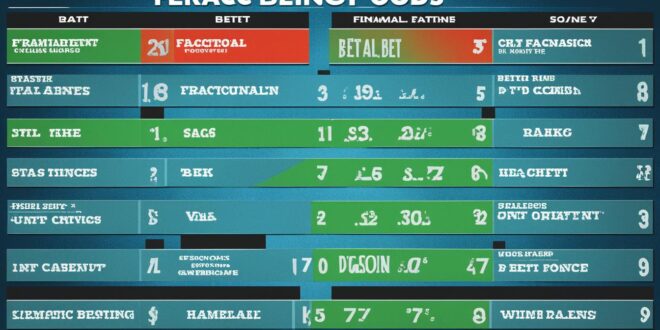The realm of sports betting can be as exhilarating as it is bewildering for newcomers. Central to the experience are betting odds, which serve as the linchpin to successful wagering. For those dabbling in this form of entertainment for the first time, betting odds explained in clear terms can be the difference between thrill and confusion. How to read betting odds and a rudimentary appreciation for what the numbers convey is foundational to not just participating, but potentially excelling in the practice.
Understanding betting odds for beginners starts with recognizing that these figures are more than just random numbers. Instead, they are carefully considered assessments put forth by sportsbooks, reflecting the likelihood of various outcomes in a game or event. The American system, with its telltale pluses and minuses, specifically encapsulates the perceived probabilities and consequently, the potential winnings pegged to a standard $100 bet. Grasping these concepts is essential for any beginner earnestly venturing into the vibrant world of sports betting.
As we navigate through the complexities of odds, we learn that they are the heartbeat of the betting world. Not only do they inform the bettor of the stakes involved, but they also imply the strategic underpinnings essential for making informed bets. With this guide, we illuminate the path for bettors stepping into the sportsbook fray, arming them with the knowledge to read and leverage odds to their advantage.
Introduction to Betting Odds for Beginners

Entering the world of betting, be it through ambient casino floors or the digital vestibules of online sportsbooks, an understanding of the types of betting odds serves as the Grundstein of any budding punter’s journey. Betting odds are, at their core, a numerical distillation of an oddsmaker’s insight into the potential outcomes of a sporting contest, intricately woven into the fabric of the betting industry itself.
To the newcomer, these odds may present themselves in varied visages – the stark simplicity of the American (moneyline), the traditional fractions of the British landscape, or the clarity of the European decimal. Yet, beneath their differing exteriors, they maintain a singularity of purpose: tactically showcasing the stake necessary to harvest a predestined profit.
- American (moneyline) odds, often marked by a leading plus or minus sign, denote the sum wagered to win $100 or the amount one could win on a $100 bet, respectively.
- Fractional (British) odds, appearing as a dyadic alliance of numbers, speak to the potential profit as compared to the stake. A 5/1 odd represents a $5 profit for a $1 bet, not including the return of the initial stake.
- Decimal (European) odds, the most straightforward of all, multiply the stake by the decimal figure provided, succinctly summarizing the total payout – stake included.
Yet, the art of betting extends beyond the mere encounter with these types of betting odds; it delves into the psychology embedded within their presentation. Odds manifest the oddsmaker’s belief system, a quantified premonition about a sporting event that adjusts the scales of risk and reward, triggering psychological responses from bettors. Ingratiating oneself with this intellectual exchange is the prelude to educated betting endeavors.
Grasping the implied probability intimated by these odds is tantamount to comprehending the betting researchers’ language, opening a lexicon of payout expectations and becoming a medium of wagering fluency. A 2/1 odd, transmutes into a 33.3% probability of occurrence; the oddsmaker’s educated conjecture elevates from abstraction to a staking guideline.
And thus, navigating through this ocean of numbers, a novice gambler embarks on a voyage of enlightenment, one bet, one odd, one game at a time.
The Basic Concept of Betting Odds
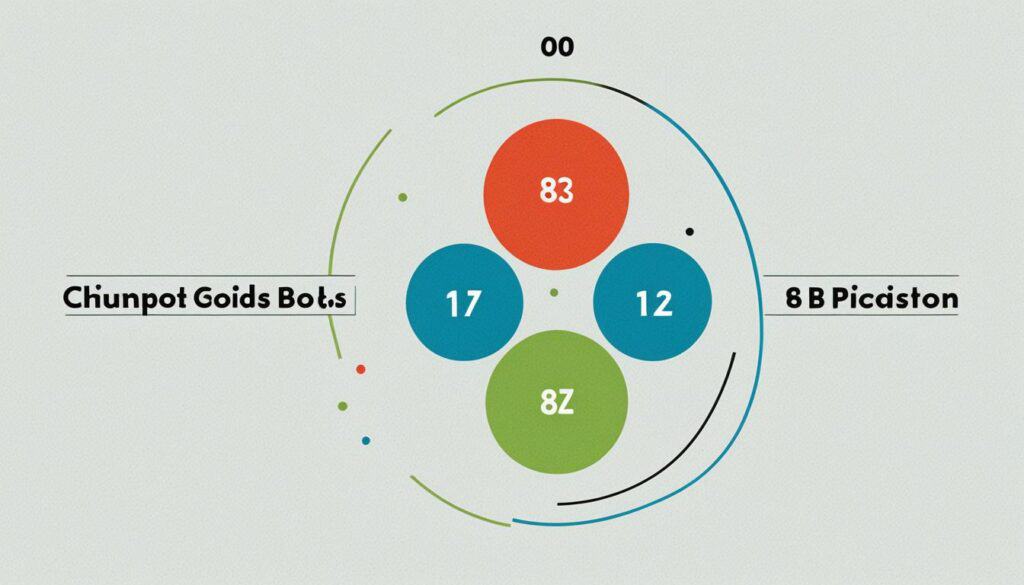
For those new to the wagering world, comprehending the essence of betting odds is essential. Betting odds are not just random numbers but are meticulously crafted to represent the probabilities of varying outcomes in any given sporting event. These figures are pivotal in guiding bettors to make informed decisions, and grasping how they work can significantly enhance your betting experience.
Defining Betting Odds
Betting odds serve as a fundamental tool within the gambling landscape, providing bettors with vital information about the likelihood of an event’s outcome. They encapsulate the risk involved in placing a wager and the possible reward for taking that risk. Simply put, betting odds explained in the most practical sense disclose how much a bettor stands to win against their stake.
How Betting Odds Reflect Probability
Betting odds and probability are two sides of the same coin. Bookmakers express their calculated assessment of an event’s chance of happening through odds. This calculated viewpoint translates into implied probabilities—where the odds given for a specific event correlate with its chance of occurring. Therefore, understanding betting odds for beginners means learning to discern these implied probabilities, which can guide one’s betting choices.
- Low odds indicate a greater probability of occurrence and thus a smaller return on a winning bet.
- High odds signify a lesser likelihood of an event taking place but offer greater rewards if the bet wins.
The Role of the Sportsbook
Sportsbooks have the complex task of setting and adjusting odds to not only reflect probable outcomes but also to manage risk and ensure their own sustainability. The betting odds psychology involves a delicate balance—sportsbooks must attract an equal amount of wagering on all possible outcomes while also securing their profit margins. The mechanism they use to retain these margins is known as the vigorish or ‘vig’, subtly embedded in the odds to ensure that the house always holds an advantage.
- Sportsbooks adjust odds to shape betting behavior and guarantee their economic viability.
- The vigorish is an integral component of the betting odds, affecting a bettor’s net gain.
Betting Odds Explained: The Plus/Minus System
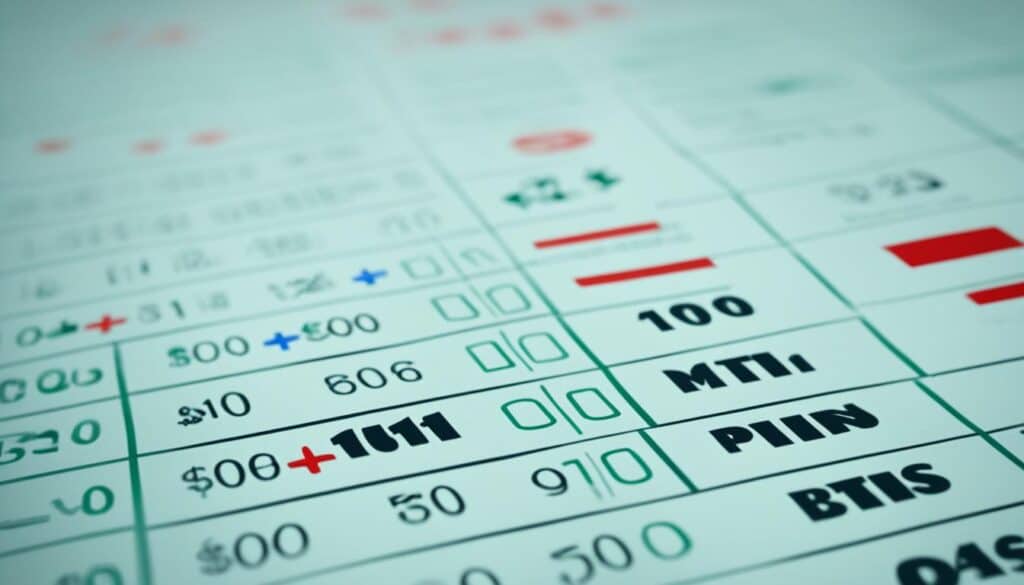
When engaging in sports betting, understanding the plus/minus system in American betting odds is crucial for making informed decisions. This system is an integral part of how betting odds work and plays a significant role in betting odds psychology.
What Plus and Minus Signs Mean in Betting
The representation of underdogs and favorites through plus (+) and minus (-) signs is not an arbitrary choice but a calculated indication that affects how to read betting odds. A “+200” odds mean you could win $200 on a $100 bet if the underdog comes out on top, while a “-200” odds suggest you would need to bet $200 on the favorite to win $100. Recognizing these signs is the first step in comprehending the framework within which betting odds explained come to life.
Interpreting Odds for Favored Outcomes
The dynamics of interpreting favored outcomes in betting are intrinsically linked to the plus and minus signs. Negative odds indicate that a team or competitor is the expected winner and therefore comes with a lower payout due to the higher likelihood of winning, reflecting inherent components of betting odds psychology. Conversely, underdogs are paired with positive odds, suggesting a less likely win which, if successful, yields a higher payout. This knowledge aids bettors in building sound betting strategies and developing a deeper understanding of oddsmakers’ intentions.
Types of Betting Odds

Embarking on the journey to understand betting odds is a critical step towards becoming a seasoned sports bettor. Among the various types of betting odds, American odds are perhaps the most straightforward and commonly used in sportsbooks across the United States.
Understanding American Odds
How betting odds work can be broken down into the favorites and the underdogs, denoted by minus (-) and plus (+) signs, respectively. A baseline figure of $100 is used for ease of understanding the payouts and stakes. For example, odds of -200 indicate that a bettor needs to wager $200 to win $100, signifying a favored outcome. Conversely, odds of +200 suggest a $100 win if one places a $100 bet, pointing to a less favored outcome. This methodology lies at the heart of understanding betting odds for beginners.
Calculating Potential Payouts with American Odds
Understanding betting odds and probability is vital when calculating potential payouts. Negative odds demonstrate how much money must be wagered to win $100, while positive odds indicate the profit on a $100 stake. For odds of +150, the calculation is simple: a $100 bet would return $150 in winnings, above and beyond the initial bet. On the flip side, odds of -150 require one to bet $150 to win $100, outlining the direct relationship between risk levels and potential reward.
Examples of American Odds in Action
For anyone keen on getting to grips with how to read betting odds, practical examples are invaluable. Take a scenario where the New York Giants are listed with +300 odds against the Philadelphia Eagles, who stand at -300. Betting on the Giants means a $100 bet could net a $300 profit if they win, showcasing the outsider’s chance. Meanwhile, a wager on the Eagles would demand a $300 bet to win $100, reflecting their tag as favorites. These real-life contexts provide clarity on betting odds explained in action, enhancing the assimilation of how American odds concretely work.
How to Read Fractional (British) Odds
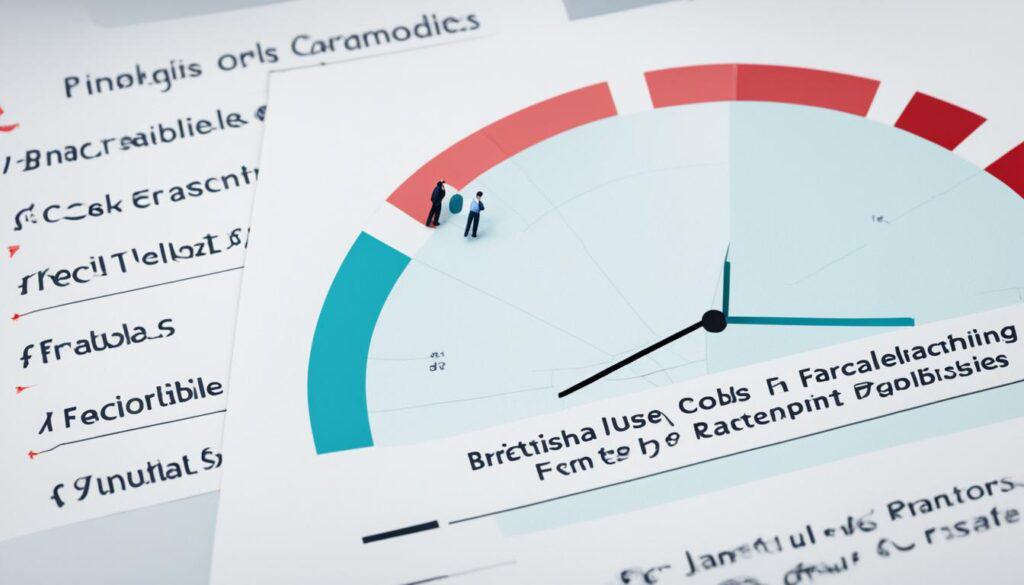
For many bettors in the United Kingdom and those dabbling in international sportsbooks, understanding fractional odds is key to informed betting. Known for their distinct presentation, these odds represent the win-stake ratio essential to calculating potential returns. They offer insight into how betting odds work and provide a clear picture of the profit possibilities on offer.
Converting Fractional Odds to Potential Winnings
To grasp betting odds explained through the fractional format, one must learn to gauge possible earnings against their wagers. Commonly displayed as 5/1, 10/3, or any other fraction, it’s crucial to understand that the first number represents the profit earned in relation to the second number, which is the stake. If you’re curious about how to read betting odds in this format, it involves simple multiplication. For example, at 6/1 odds, a $2 bet results in $12 profit, plus the initial $2 stake returned, for a total payout of $14.
Understanding Fractional Odds Through Examples
Visual examples are often the most effective way to understand the types of betting odds. Let’s consider three instances:
- A $10 bet on 13/5 odds yields a $26 profit, thus a total payout will be $36, including your original bet.
- Placing $10 on odds of 9/2 provides a return of $45 profit, making the cumulative payout $55.
- Finally, betting $10 at 7/1 odds would result in a $70 profit, amounting to an $80 payout including the stake.
These scenarios demonstrate the functionality of fractional odds, guiding bettors in forecasting earnings for events of varying probabilities. They embody the betting odds explained for beginners, showcasing the relationship between the risk taken and potential reward.
Decimal (European) Odds and Their Usage
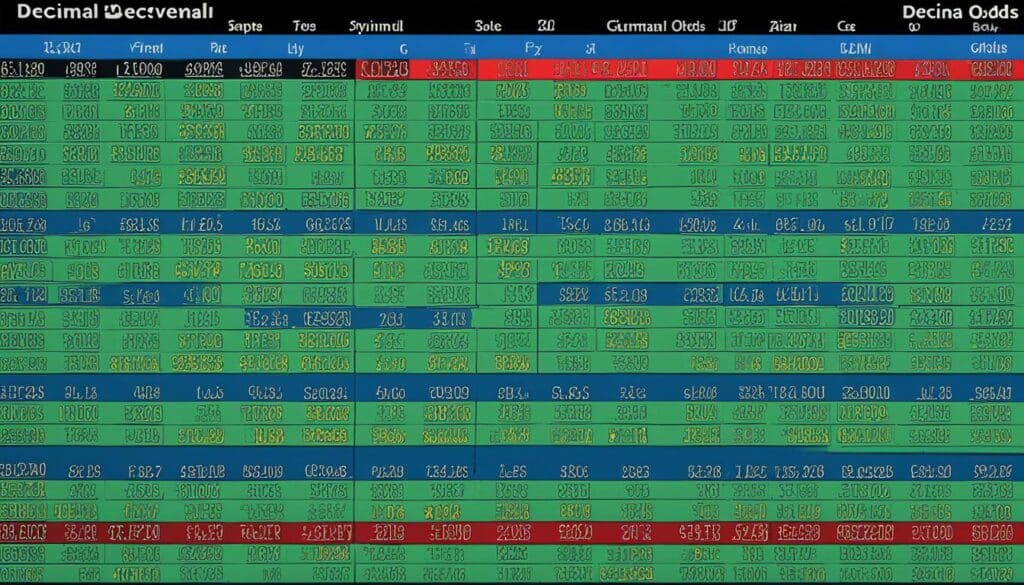
Delving into the diverse world of sports betting, one finds decimal odds to be a cornerstone of modern wagering. These odds, paramount in regions such as Europe and Australia, offer a seamless method for calculating total payouts, integrating both the return on the wager and the stake itself into one number. This ease of computation makes understanding betting odds for beginners markedly more accessible and transparent.
Easy Conversion from Decimal Odds to Total Payout
Grasping the mechanics of decimal odds is a straightforward affair. The formula involves nothing more than multiplying the stake by the decimal odds figure to ascertain the total payout. This calculation, fundamental in how betting odds work, demonstrates the user-friendly nature of this type that has propelled its usage across betting platforms.
- To exemplify, a bet of $10 at decimal odds of 2.5 would return a total payout of $25.00.
- This figure includes both the profit of $15 and the original $10 stake, emphasizing the practicality of this format in providing direct insight into the potential returns.
International Popularity of Decimal Odds
Decimal odds have transcended the borders of their traditional strongholds to achieve a global presence in the betting arena. Their increasing adoption by U.S. sportsbooks illustrates their appeal, merging harmoniously with other types of betting odds like American and fractional odds. The inherent simplicity and transparency of decimal odds echo the evolving needs of the international betting community, confirming their crucial role in betting odds explained to a worldwide audience.
As a tool that balances sophistication with simplicity, decimal odds cater with equal finesse to both the experienced bettor and novices seeking understanding betting odds for beginners. With broader acceptance, this trend is shaping a unified approach to reading and interpreting betting odds across the globe.
The Vigorish Explained: Sportsbook’s Cut

When diving into the mechanics of betting, understanding the vigorish—commonly known as the vig—is essential for any bettor. This term refers to the commission that sportsbooks impose on bets, which serves as their source of income. It’s a critical element that affects betting odds and probability, as well as the potential profitability for bettors. By comprehending how the vigorish works, bettors gain insight into how to read betting odds more effectively and can better estimate their true chances of winning.
Understanding How Vigorish Affects Your Bets
The influence of vigorish on your betting strategy cannot be overstated. With standard betting odds set at -110, the sportsbook essentially levies a tax on every placed bet. This system ensures that the bookmaker garners profit regardless of the game’s outcome. For bettors, it’s crucial to identify betting odds that have factored in the vigorish to arrive at precise calculations of potential wins and losses. In understanding the vig, one grasps a more transparent view of the betting odds explained by the sportsbook.
Calculating the Impact of Vig on Bets
Assessing the impact of the vigorish on your placed bets is a matter of simple arithmetic. Odds with a -110 label indicate that for every $10 one hopes to win, an initial $11 wager is required. This additional $1 pays for the sportsbook’s services. Calculating the bookmaker’s overround, or implied probability, is essential to discern how betting odds work in their favor. Grasping these calculations will endow bettors with a realistic expectation of the probable net winnings after the sportsbook’s cut has been accounted for.
- Identify the Odds: Look for game lines and odds, typically marked as -110 for favorites or underdogs, signaling the inclusion of the vig.
- Understand the Math: Calculate the vig’s impact by assessing how much extra is needed to win a targeted amount, keeping in mind the sportsbook’s implied probability.
- Shop for Odds: Compare odds across sportsbooks, as some may offer more favorable terms that reduce the vig’s impact on potential profits.
Comparing Different Types of Odds
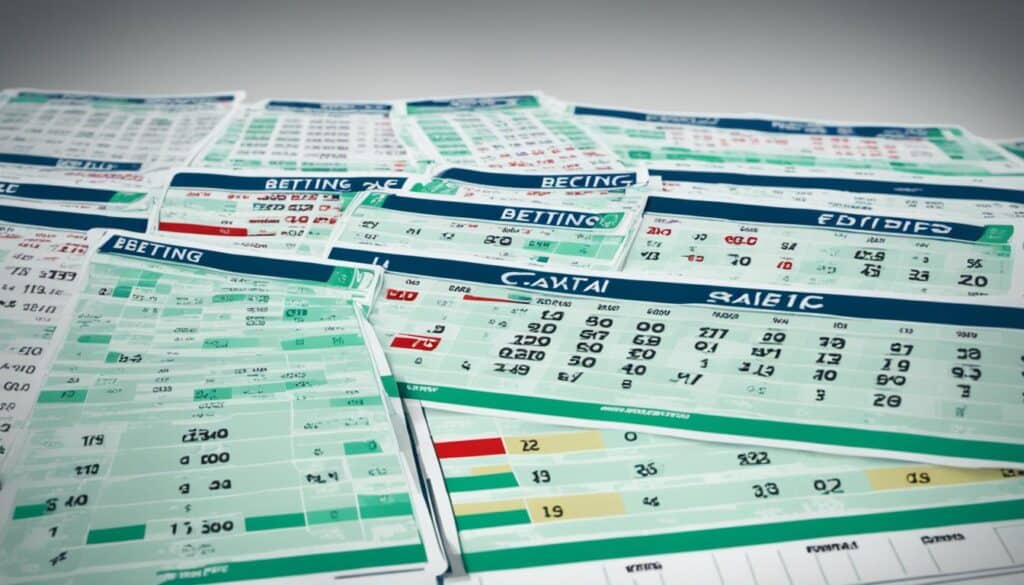
As we delve deeper into the world of sports betting, it becomes clear that understanding the various types of betting odds is a key stepping stone to making informed wagers. Whether you encounter American, fractional, or decimal odds, the principle remains the same: odds are a way of expressing betting odds and probability. Moreover, knowledge of how betting odds work across different formats can significantly enhance a bettor’s ability to compare and convert odds effectively.
Why Odds Formats Do Not Affect Payouts
The heart of betting lies in the odds, yet, regardless of their format, they serve the same purpose—conveying the implied probability of an event. It’s important for bettors to understand that whether odds are given in the American, fractional, or decimal form, the potential winnings do not vary. The odds may be presented differently, but they reflect an equivalent chance of success and corresponding payout, anchoring a universal truth within the betting landscape that payouts are consistent across different odds formats.
Converting Odds Between Formats
Bettors often face situations where they need to convert one odds format to another—be it from American to fractional or from fractional to decimal. Mastering these conversions allows bettors to seamlessly navigate platforms worldwide. Below is a guide on how to translate these different types of betting odds:
- American (+200) to Fractional (2/1): Indicates a $200 win on a $100 bet.
- Fractional (2/1) to Decimal (3.00): Shows that for every dollar bet, the total return would be three dollars including the original stake.
- Decimal (3.00) to American (+200): Similarly, it reflects the same $200 winnings for a $100 stake.
The ability to convert betting odds is an indispensable skill within the global betting market. It ensures a comprehensive understanding and application of betting strategies, no matter the format, thus bridging cultural and regional divides in the realm of sports betting.
Implied Probability and Betting Strategy
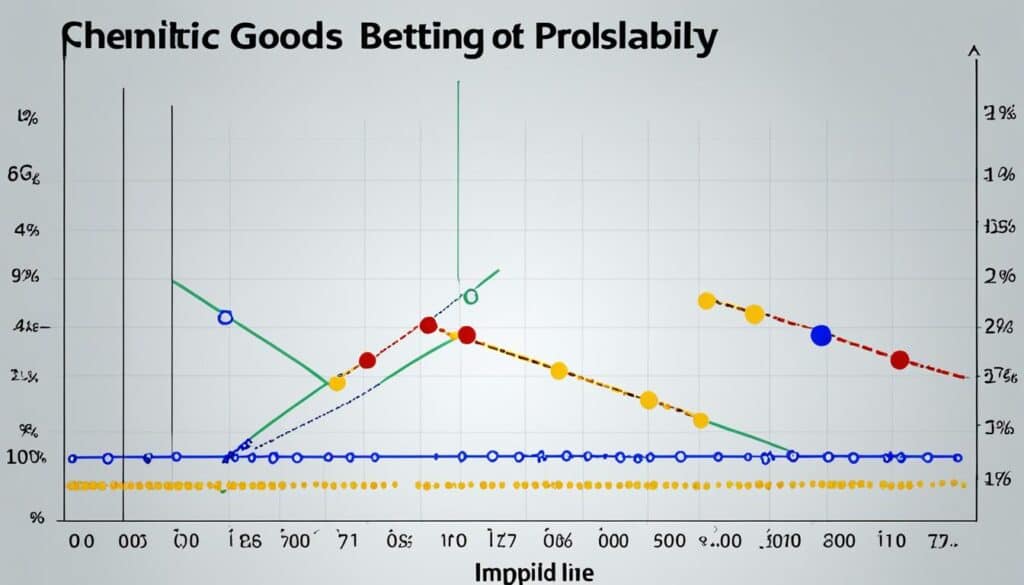
When delving into the granular world of sports betting, an understanding of implied probability is key to developing an astute betting strategy. It’s a gauge that represents the bookmaker’s opinion on the likelihood of an event’s outcome. As bettors fine-tune their ability to convert betting odds into implied probability, they equip themselves with the knowledge to craft informed bets that offer a tangible edge over the typical guesswork involved in gambling.
Converting Odds into Implied Probability
To transform American betting odds into implied probability, the formulas differ for favorites and underdogs due to the positive or negative values of the odds. Bettors must utilize the appropriate methods to accurately gauge the sportsbook’s perceived probability of an event. This calculation plays a critical role in determining where to place bets and how betting odds work within the framework of an informed wagering strategy. The understanding of these mathematical nuances can be the linchpin in discovering betting opportunities with increased expected value.
- For favorites (negative American odds): Implied Probability (%) = Odds/(Odds + 100) * 100
- For underdogs (positive American odds): Implied Probability (%) = 100/(Odds + 100) * 100
Finding Value in Betting Odds
Identifying value in betting odds is about more than just grasping betting odds explained in simple terms; it’s an exploration into betting odds psychology. When a bettor’s own assessment of an event’s likelihood is greater than that suggested by the implied probability, there lies a potential avenue for a value bet. Such bets could represent discrepancies between public sentiment and actual prospects, thus presenting advantageous situations for the shrewd bettor. By dissecting betting odds and probability, even those new to sports betting can unearth prospects of superior potential returns.
- Comparing personal assessments with bookmaker probabilities
- Seeking potential mismatches indicating value bets
- Applying a strategic approach to bets with higher perceived value
Critical analysis of odds must underpin every betting decision, involving a deep dive into how betting odds work. Arming oneself with the knowledge to calculate implied probability encourages a level of betting that transcends guesswork, thereby propelling one’s strategy from a game of chance to one of skill and informed decision-making.
Betting Odds Explained: Common Misconceptions

When embarking on the journey of sports betting, gaining a solid understanding betting odds for beginners is pivotal. Yet, certain fallacies about these odds often mislead novices, hindering their ability to read betting odds effectively. Let’s debunk some of these widespread misunderstandings and establish a clearer perspective for aspiring bettors.
- The notion that odds directly reflect the certainty of an outcome’s occurrence is a misapprehension. In reality, odds represent the bookmaker’s perception of probability, with an incorporated margin that safeguards their profit.
- A favorite’s odds may indicate a greater likelihood of winning, but that is not a certitude. The world of competitive sports is rife with upsets, and the payouts offered for favorites are lower as a buffer against potential losses from such unexpected outcomes.
- It’s a fallacy to presume that complex odds equate to better value. Odds are merely a translation of probability into a financial framework. Therefore, the true skill lies in discerning the value within these odds, whatever their form.
Indeed, overcoming these misconceptions is crucial. A refined comprehension of how odds operate and what they truly signify transforms a casual punter into an informed strategical thinker. For beginners aiming to navigate the nuanced seas of sports betting, shattering such myths engenders a realistic and measured approach to wagering.
Understanding the Odds – Beyond Basics

Advancing from the fundamental understanding of how betting odds work to grasping their application within sophisticated betting tactics is essential for seasoned bettors aiming for long-term success. Knowledge of betting odds explained through a simple win-lose scenario is just the starting point; the real expertise lies in leveraging those odds with smart betting strategies.
Advanced Betting Concepts Linked to Odds
The interplay of betting odds psychology and advanced betting concepts drives the strategic aspect of wagering. Among these concepts, three particularly stand out:
- Hedging Bets: This technique involves placing wagers on multiple outcomes to guarantee a profit or minimize potential loss, irrespective of the final result.
- Arbitrage: Savvy bettors seek opportunities where they can bet on all possible outcomes of an event across different sportsbooks, to lock in a risk-free profit due to varying odds.
- Betting Trends Analysis: Recognizing and understanding patterns within bet placement over time can reveal insights into market movements and the mindset of oddsmakers.
Delving into these advanced methods enables bettors to refine their approach toward betting, often yielding a more significant return on their investments.
Utilizing Odds in Betting Strategies
To make the most of the types of betting odds, it’s imperative to include odds consideration at the core of betting strategies:
- Monitor shifts in odds to detect changes in public perception or new information influencing event outcomes.
- Calculate the risk-to-reward ratio to understand the value of a bet better.
- Plan bets strategically, considering long-term profitability instead of fleeting gains.
Shifting odds can be indicative of more than just a contender’s likelihood of success; they may also reflect external factors such as player injuries or weather conditions, which can impact the outcome of the event. By incorporating these variances and understanding the deeper implications they hold, a bettor can make more informed decisions.
At its core, the proper utilization of betting odds within one’s strategy means developing a betting process that goes beyond impulse, employing meticulous risk assessment and a deeper appreciation for the role odds play in successful wagering. This is the pathway to excelling in the art of gambling for any bettor committed to not just participating but thriving in the world of sports betting.
Betting Odds in Online and Offline Casinos

Whether you’re staking your chips in the plush settings of a traditional casino or clicking away in the digital lounge of its online counterpart, understanding the dynamics of betting odds explained is crucial. In both realms, the odds are used not just as markers for potential payouts, but also as a reflection of the house edge—a concept every gambler should be intimate with. In games like craps, roulette, and poker, proficiency in how to read betting odds can help you manage your bankroll wisely and make decisions that tilt the balance in your favor.
In the casino’s setting, odds manifest in ways that can be slightly different from sports betting. Here are some ways in which they influence gaming behavior:
-
Guidance for Payouts: In casino games, the odds determine the rate at which players are paid out, thus informing their betting choices—whether to take a risk on a long shot or play it safe with bets that have better odds.
-
Insight into House Edge: Knowledge of odds provides insight into the casino’s advantage in any given game, enabling players to assess the risk associated with each bet.
-
Influencing Betting Styles: With an understanding of odds, players can adopt betting styles and strategies that align with their individual risk tolerance and goals.
For beginners, grasping the nuances of odds is a step towards becoming savvy bettors. For veterans, it’s an ongoing commitment to discipline and strategic gaming. Regardless of the setting or the format, the significance of betting odds remains immutable—a lighthouse guiding gamblers in a sea of chance.
Legal Landscape of Betting in the United States

The legal landscape of betting in the United States experienced a significant shift with the Supreme Court’s decision in 2018, altering the trajectory of sports betting nationwide. This transformative moment created a ripple effect that is still evolving, with variations in acceptance and regulation from state to state. For those striving to understand betting odds for beginners, recognizing the interplay between the legal framework and betting practices is crucial. It not only influences accessibility to various betting platforms but also shapes the kinds of bets that can be lawfully placed.
The Impact of the 2018 Supreme Court Decision
With the Supreme Court’s landmark ruling in 2018, the federal ban on sports betting was overturned, granting individual states the autonomy to dictate their sports wagering laws. This pivotal change dismantled years of restricted sports betting activity, fostering an environment where states could embrace the economic potential of legalized sports betting. For beginners, this shift has implications for the betting odds explained; a variety of betting options and odds are now legally available, introducing a newfound complexity to navigate.
State-by-State Adoption of Sports Betting
As the legal landscape of betting continues to unfurl, a state-by-state patchwork of regulation has emerged. The adoption of sports betting has been anything but uniform, with some states swiftly moving to legalize and regulate all forms of sports betting, while others adopt a more measured approach or remain in legislative limbo. This state-level mosaic dictates the betting landscape, with a direct impact on understanding betting odds for beginners—it’s essential to be conversant with the legal nuances present in one’s state to effectively participate in sports betting.
Tips for Beginners: Betting Odds and Bankroll Management
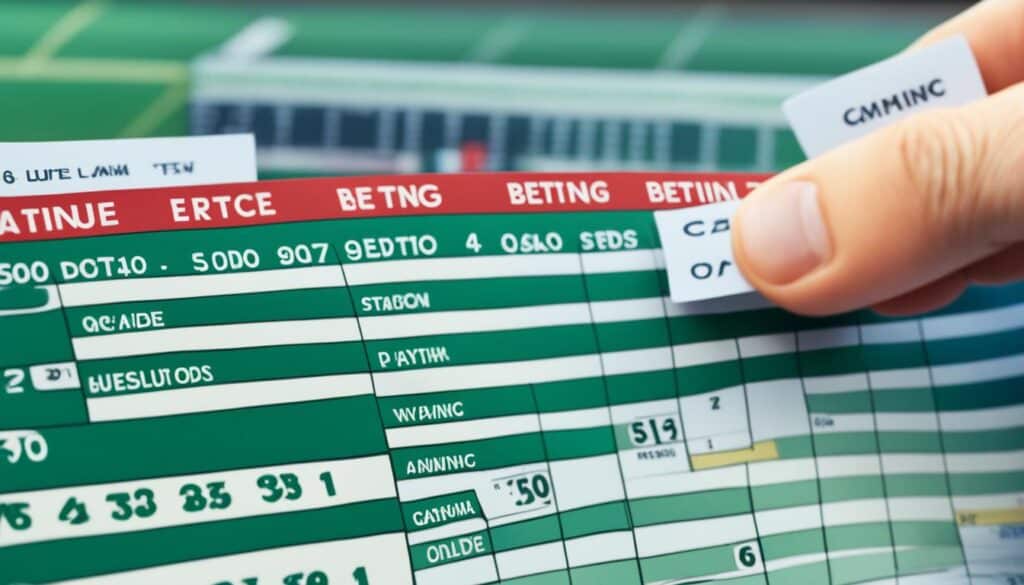
Embarking on the journey of sports betting requires not just a solid grasp of how betting odds work but also a disciplined approach to bankroll management. Novice bettors should focus on understanding betting odds for beginners and recognize how these odds mirror betting odds and probability. Additionally, it’s prudent to have strategies in place that help dictate the smart deployment of funds.
Smart Betting Practices for Newbies
Navigating through the maze of types of betting odds can seem daunting for beginners. A logical first step is to apply certain smart betting guidelines that can steer new bettors towards more thoughtful wagering.
- Thoroughly familiarize with how various betting odds formats reflect potential outcomes.
- Meticulously set a spending limit for your betting activities and adhere to it to avoid financial setbacks.
- Resist the urge to place bets based on emotion rather than rational analysis and sound judgment.
- Utilize tools such as betting odds calculators and converters to understand the potential impact of your bets.
Setting Realistic Expectations with Betting Odds
Understanding betting odds is not just about forecasting wins; it’s about setting grounded expectations based on probabilities. New bettors often overlook that odds provide a guide rather than a guarantee and must appreciate the unpredictability inherent in sports betting.
- Accept that odds signify chance and not certainty, reinforcing the need for responsible wagering.
- Look beyond the favorites, considering that underdogs can present lucrative, though riskier, betting opportunities.
- Recognize that outcomes are not pre-determined, and managing one’s bankroll is crucial in the long run.
- Develop a betting strategy aligned with the mathematical indications provided by odds rather than hunches or unfounded confidence.
By instilling these prudent betting habits and mindfulness of financial constraints, novice bettors can considerably enhance their sports betting experiences and develop into more sophisticated, shrewd participants in the betting arena.
Online Tools: Betting Odds Calculators and Converters
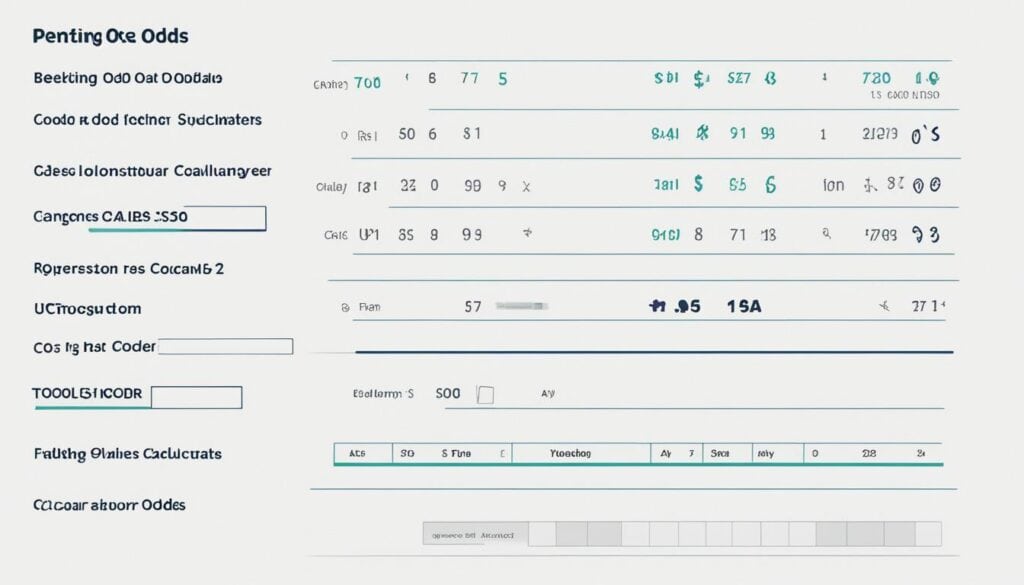
For those new to sports betting or looking to streamline their approach, online tools specifically designed to decode and interpret betting odds can provide a world of assistance. Understanding how to read betting odds with ease and precision is crucial, and this is where betting odds calculators and converters play a significant role. These digital assets have become an integral part of the betting toolkit, especially for beginners aiming for clarity on potential bet outcomes and payoffs.
Betting odds explained through these tools can vary in functionality, but the core value they offer remains the same — they break down the complexities of odds conversion and calculation, enabling bettors to transition between American, fractional, and decimal odds effortlessly. Utilizing these tools ensures that you have a solid grasp on the stakes involved and the rewards that could be reaped from each bet.
- Swift Conversion: Instantly transform American odds to fractional or decimal odds, helping to compare different betting opportunities regardless of the odds format displayed.
- Accurate Potential Return Calculations: Determine potential winnings from decimal odds or assess the risk-reward from fractional odds without manual calculations.
- Implied Probability Analysis: Translate betting odds into implied probability percentages, giving a clearer picture of an event’s likelihood.
- Fiscally Informed Betting: Gauge a bet’s value by understanding what the odds mean for your wallet, especially when managing a betting bankroll with precision.
These calculators and converters cater to varying betting preferences and requirements, making them ideal companions for any serious bettor looking to make informed decisions. The art of how to read betting odds and fully understanding each wager lays the foundation for a more strategic and enjoyable betting experience.
Incorporating these digital aids into your betting practice not only enhances your expertise but also acts as a safeguard against common misunderstandings that can lead to placing suboptimal bets. Make these tools a fundamental part of your betting arsenal to ensure that your next wager is placed with confidence and knowledge.
Key Takeaways and Next Steps in Betting
Embarking on the betting journey requires a solid foundation in the fundamentals. Beginners must prioritize understanding betting odds, as these reflect the implied probability of each possible outcome. Throughout this guide, we’ve uncovered that the psychology behind betting odds and how they are crafted by bookmakers can significantly affect betting decisions. By appreciating that odds are an amalgamation of risk assessment, market sentiment, and bookmaker strategy, bettors can refine their wagers to be more strategic and informed.
The next steps involve taking the comprehensive knowledge accrued on moneyline, fractional, and decimal odds and applying it to actual betting scenarios. Such practical experience will cement a bettor’s understanding of how odds work and contribute to a deeper grasp of the intricacies of betting odds psychology. Moreover, as the legal landscape for sports betting widens, understanding betting odds for beginners becomes even more crucial. Entering the market without a firm understanding of these concepts could prove overwhelming and financially unwise.
Finally, the advancement and sophistication in one’s betting acumen should be a perpetual process. Continuous learning, frequent analysis, and a disciplined approach to bankroll management are pivotal in evolving from a novice to a seasoned bettor. By remaining vigilant and prudent, enthusiasts of sports betting can navigate the evolving terrain with confidence, equipped with the crucial insights that this guide has provided.
 Online Gaming Circuit
Online Gaming Circuit
